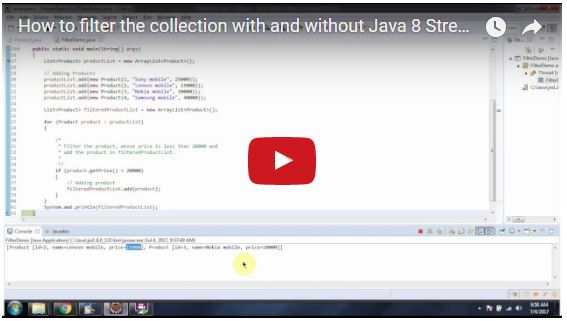Click here to watch in Youtube :
https://www.youtube.com/watch?v=Ba0gD6_QqK4&list=UUhwKlOVR041tngjerWxVccw
Product.java
https://sites.google.com/site/ramj2eev1/home/javabasics/StreamDemo_filter_productList_app.zip?attredirects=0&d=1
Github Link:
https://github.com/ramram43210/Java/tree/master/BasicJava/StreamDemo_filter_productList_app
Bitbucket Link:
https://bitbucket.org/ramram43210/java/src/64bafbc8f43e8865b0cd21a106383d7ae583fbc8/BasicJava/StreamDemo_filter_productList_app/?at=master
See also:
All JavaEE Viedos Playlist
All JavaEE Viedos
All JAVA EE Links
Servlets Tutorial
All Design Patterns Links
JDBC Tutorial
Java Collection Framework Tutorial
JAVA Tutorial
Kids Tutorial
https://www.youtube.com/watch?v=Ba0gD6_QqK4&list=UUhwKlOVR041tngjerWxVccw
Product.java
class Product { private int id; private String name; private int price; public Product(int id, String name, int price) { super(); this.id = id; this.name = name; this.price = price; } public int getId() { return id; } public void setId(int id) { this.id = id; } public String getName() { return name; } public void setName(String name) { this.name = name; } public int getPrice() { return price; } public void setPrice(int price) { this.price = price; } @Override public String toString() { return "Product [id=" + id + ", name=" + name + ", price=" + price + "]"; } }FilterDemo.java
import java.util.ArrayList; import java.util.List; /** * Filtering Collection without using Stream: * * In this example, We are filtering data without using * stream. This approach we are used before the stream package was * released. * */ public class FilterDemo { public static void main(String[] args) { List<Product> productList = new ArrayList<Product>(); // Adding Products productList.add(new Product(1, "Sony mobile", 25000)); productList.add(new Product(2, "Lenovo mobile", 15000)); productList.add(new Product(3, "Nokia mobile", 10000)); productList.add(new Product(4, "Samsung mobile", 40000)); List<Product> filteredProductList = new ArrayList<Product>(); for (Product product : productList) { /* * Filter the product, whose price is less than 20000 and * add the product in filteredProductList. * */ if (product.getPrice() < 20000) { // Adding product filteredProductList.add(product); } } System.out.println(filteredProductList); } }Output
[Product [id=2, name=Lenovo mobile, price=15000], Product [id=3, name=Nokia mobile, price=10000]]StreamDemo.java
import java.util.ArrayList; import java.util.List; import java.util.stream.Collectors; /** * Filtering Collection using Stream: * * Here, we are filtering data by using stream. You can see that code * is optimized and maintained. Stream provides fast execution. * */ public class StreamDemo { public static void main(String[] args) { List<Product> productList = new ArrayList<Product>(); // Adding Products productList.add(new Product(1, "Sony mobile", 25000)); productList.add(new Product(2, "Lenovo mobile", 15000)); productList.add(new Product(3, "Nokia mobile", 10000)); productList.add(new Product(4, "Samsung mobile", 40000)); List<Product> filteredProductList = productList.stream() .filter(p -> p.getPrice() < 20000)// Filter the product, whose price is less than 20000 .collect(Collectors.toList()); // collecting as list filteredProductList.forEach(product -> System.out.println(product)); } }Output
Product [id=2, name=Lenovo mobile, price=15000] Product [id=3, name=Nokia mobile, price=10000]Click the below link to download the code:
https://sites.google.com/site/ramj2eev1/home/javabasics/StreamDemo_filter_productList_app.zip?attredirects=0&d=1
Github Link:
https://github.com/ramram43210/Java/tree/master/BasicJava/StreamDemo_filter_productList_app
Bitbucket Link:
https://bitbucket.org/ramram43210/java/src/64bafbc8f43e8865b0cd21a106383d7ae583fbc8/BasicJava/StreamDemo_filter_productList_app/?at=master
See also:


No comments:
Post a Comment